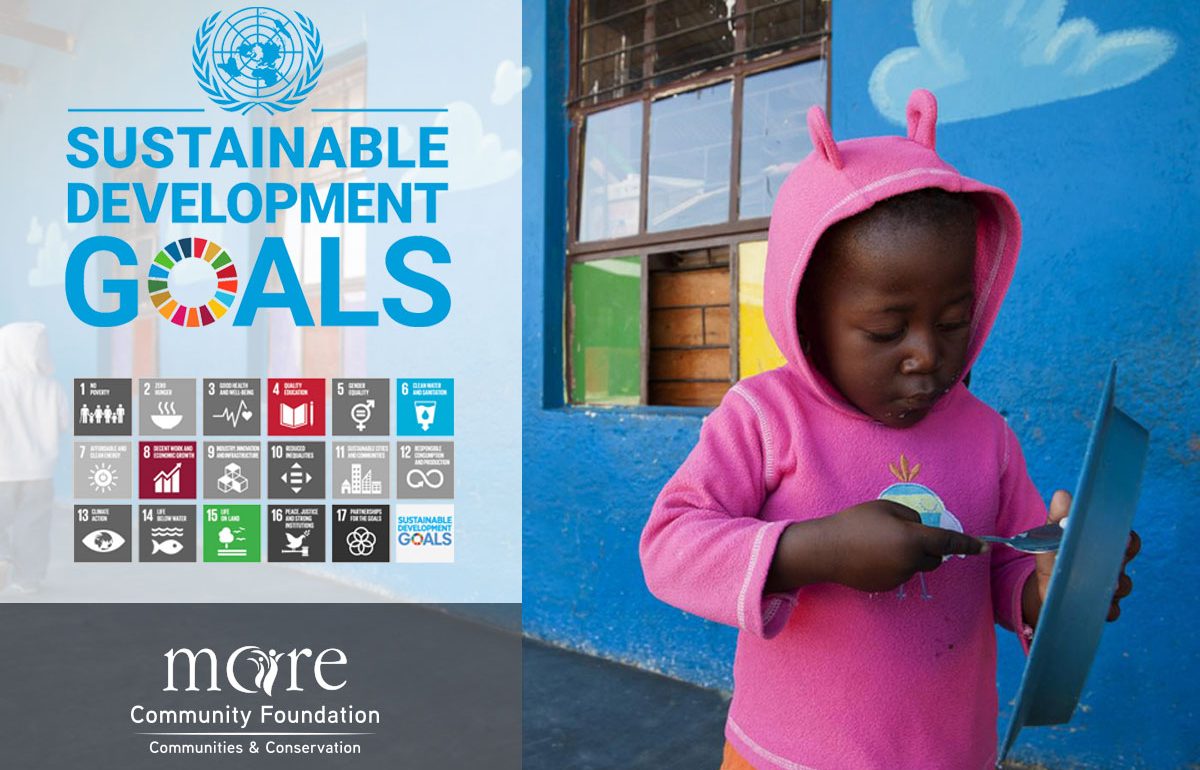Aligning with UN’s Sustainable Development Goals

The sandy veld of Bushbuckridge, a border district of South Africa abutting Mozambique, is dotted with rocky outcrops and small villages and informal settlements. Perched between the spectacular Blyde River Canyon Nature Reserve and Kruger National Park, this area has long been one of the poorest communities in South Africa.
Of about half a million people, only 70% are economically active, due to the legacies of apartheid but also constraints in the post-apartheid labour market. Serious backlogs in the provision of all services such as water, electricity, sanitation, health care and schools exacerbate the depravation, and most households depend on meagre social grants to meet their living expenses,
It was here that we first came across the Henna preschool in the 1990s, and in 2002 we began supporting the small school. This soon turned into a community development project: over time four additional classrooms and a kitchen and storeroom were built, a borehole was drilled and vegetable gardens were planted to feed both the children and the nearby residents.
The preschool became a brick-and-mortar Early Childhood Development Centre with resolute teachers and staff. Here 170 children now get quality education, daily care, nutrition, and security.
But the early work with the small school was the start of something much bigger: the non-profit More Community Foundation (initially the Bhubezi Trust and later the More Community Trust), which supports social and environmental development not only in the Bushbuckridge region, but across southern Africa. While we are firmly rooted in the local community in Bushbuckridge and have nurtured relationships with community leaders, traditional councils, municipality managers and community development forums; since humble beginnings, we have slowly expanded into four more provinces and into northern Zimbabwe.
Our mandate includes education and skills development at primary, secondary and tertiary level as well as post-graduate training, internships, and adult skills development through community-based programmes. We also facilitate the development of local black businesses and support the provision of basic human needs, focusing on food and energy security, access to basic healthcare, eco-friendly sanitation and clean, running water.
We are committed to socially inclusive conservation and environmental education, and believe it is critical to maintaining our planet’s biological diversity and the sustainable use of natural resources. This is important because the communities we serve depend strongly on ecosystem services for their livelihoods, with women and children disproportionately affected, and problems amplified by COVID-19.
All these community projects for social development are self-sustainable as we believe that they will be kept alive well into the future based on our model of communities contributing their own efforts and skills.
Enter…. sustainability
The term “sustainability” can cause eyes to glaze over and conjure problems that feel too difficult to overcome. But for us it’s not an abstract concept or boring shop talk or jargon or a box ticking exercise.
We simply must push for a sustainability-first approach. That is the only way we can ensure the Henna preschool and other local projects will outlast future pandemics and wars and financial crises and political turmoil. We experience the importance of sustainability at local level, but it is part of a global language as relevant to us as it is in Guatemala, London, or Singapore.
The best – and frankly still the only – framework for sustainable development is the United Nations’ blueprint for peace and prosperity, the Sustainable Development Goals. The 17 Goals remain the most important to-do list in the history of humankind. Yet SDG outcomes have been significantly eroded by COVID-19, and in emerging markets, by economic downtown,
Now, at the halfway point in the 2030 Agenda for Sustainable Development, achieving the targets set forth by the SDGs is more urgent than ever. UN Secretary-General Antóno Guterres recently warned that, with “cascading and interlinked global crises, the aspirations set out … are in jeopardy.”
The SDGs were adopted unanimously by all world leaders in 2015. They are global goals to end poverty, create decent work and protect the natural environment by 2030.
The fact is we can’t leave it only to governments to reach these ambitious goals. Civil society plays a role and we have to make it happen where we are. It is a daunting prospect, but the SDGs give us not only the language and the framework to face up to these global issues, but also the power to make an impact globally with what we do locally.
Our experience in communities from Bushbuckridge to Cape Town and Johannesburg backs up the premise of the SDGs: that ending poverty and other deprivations must go together with strategies that improve health and education, reduce inequality, and spur economic growth – all while tackling climate change and working to preserve our oceans and forests.
Lofty goals made real
Each of the SDGs – there are seventeen – has a specific aim and outlook. But there is also a significant overlap between them and while we align primarily with four of them, all our projects fit in the broader framework of the Goals.
In the next additions of this Blog, we will highlight the work we do to achieve the targets of specific SDGs, towards a brighter future for all. Sustainability is our reality. It is a thing of beauty, a sense of hope, survival. And it is possible.